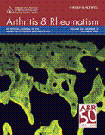Cited2 modulates hypoxia-inducible factor–dependent expression of vascular endothelial growth factor in nucleus pulposus cells of the rat intervertebral disc
Abstract
Objective
To determine whether nucleus pulposus cells of the intervertebral disc express hypoxia-inducible factor 2α (HIF-2α), and to assess the role of HIF-1 and HIF-2 in controlling cited2 and vascular endothelial growth factor (VEGF) expression.
Methods
Rat cells were cultured under normoxic (21% O2) or hypoxic (2% O2) conditions, and expression and promoter activity of HIF-2 target genes were evaluated. Gain- or loss-of-function experiments were performed to investigate the contribution of HIF isoforms to cited2 activity as well as the role of cited2 in regulating VEGF expression.
Results
We found that HIF-2α protein was expressed in vivo and that protein and messenger RNA expression were similar under both normoxic and hypoxic conditions. However, there was a significant increase in HIF-2α transactivation under hypoxic conditions. With respect to functional activity, unlike the case in most other tissues, HIF-2 failed to increase the transcriptional activities of superoxide dismutase 2 and frataxin, 2 common target genes involved in radical dismutation. However, under hypoxic conditions, HIF-2 preferentially regulated the expression and promoter activity of cited2, a p300 binding protein. When HIF-2α or HIF-1α was suppressed, cited2 promoter activity was inhibited. Finally, we showed that forced expression or suppression of cited2 resulted in corresponding changes in expression of VEGF, a common target gene for HIF-1 and HIF-2 in the nucleus pulposus cells.
Conclusion
Results of this study indicate that in nucleus pulposus cells, HIF-2 and HIF-1 modulate their own transcriptional activity through cited2. We suggest that the 2 arms of the regulatory circuit serve to maintain survival activities and inhibit angiogenesis in the healthy disc.




